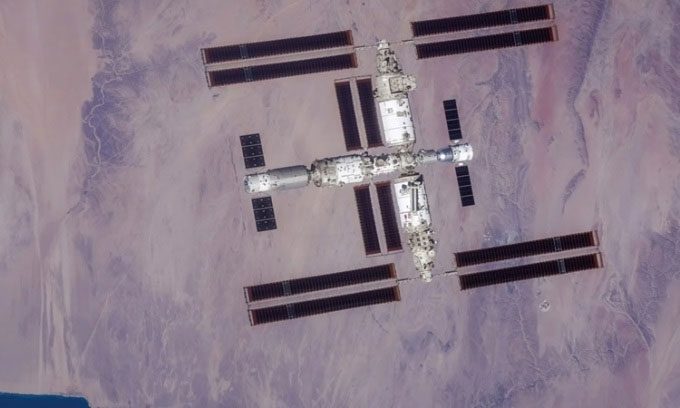Chinese authorities have shared a panoramic photo capturing the entire structure of the Tiangong space station, featuring three modules, solar panels, a robotic arm, and many other details.
The photo was taken by the Shenzhou 16 astronaut from above the Tiangong station before the spacecraft returned to Earth last month, marking a historic moment in China’s three-decade-long manned space program. The image showcases the complete T-shaped space station, weighing 90 tons, along with its massive solar panels, the main robotic arm, and various other features, with Earth serving as the backdrop, according to Space.

The Tiangong station in full configuration. (Photo: CMSA).
The photo of the Tiangong station, a project that began in 1992 and was completed last year, was announced on November 28 in Hong Kong by a representative from the China Manned Space Agency (CMSA). According to this agency, Chinese astronauts have had very few opportunities to capture a panoramic view of the Tiangong station through observation windows since construction began in 2021. However, on October 30, after separating from the Tiangong station, the Shenzhou 16 spacecraft performed a special flight around the station, allowing the crew to take photos from a distance of several hundred meters. The above image was shared by Gui Haichao, a Chinese researcher and the first civilian astronaut to travel to space.
The photo reveals the symmetrical design of the space station, featuring the Tianhe core module at the center, flanked by the Wentian and Mengtian experimental modules, each equipped with a pair of 55-meter-long solar panels. The three modules were launched separately and assembled in orbit. Additionally, the Shenzhou 17 spacecraft and the Tianzhou 6 cargo spacecraft are also docked at the front and back of the Tianhe module. The 10-meter-long robotic arm of the station is located on the Wentian module. The grooves for conducting experiments outside the station on the Mengtian module are also clearly visible in the high-resolution image.
The Chinese space station weighs 20% of that of the International Space Station (ISS), the largest artificial structure in space, which operates at a slightly higher orbit than Tiangong. However, the Tiangong station offers more space for conducting experiments and provides a more extensive environment for astronauts to live and work compared to the ISS. Chinese authorities are planning to expand the Tiangong station from a three-module T-shape to a six-module cross shape in the coming years.
The planned expanded space station is expected to weigh around 180 tons in low Earth orbit. The current Tiangong station is in its development phase and is expected to last at least 10 years. Meanwhile, the ISS is set to operate until 2030, and NASA has indicated that the cost of decommissioning the station could amount to one billion USD.


















































